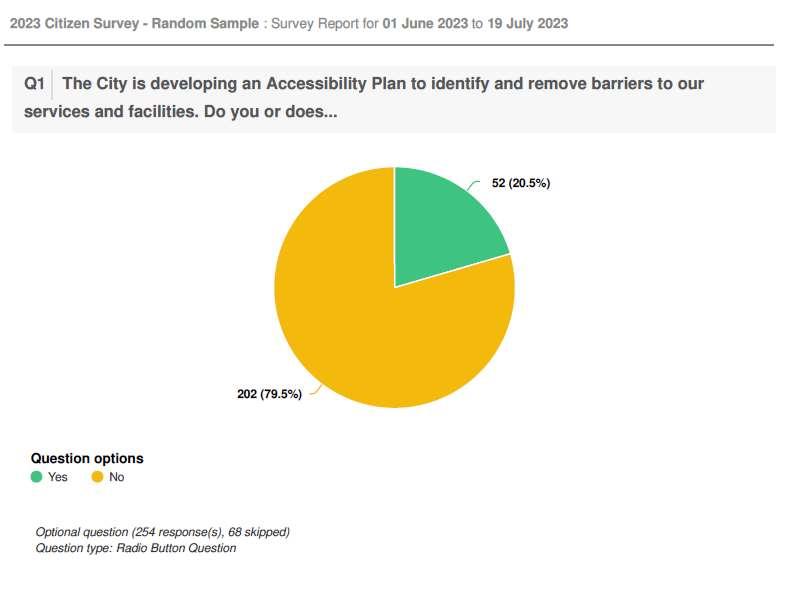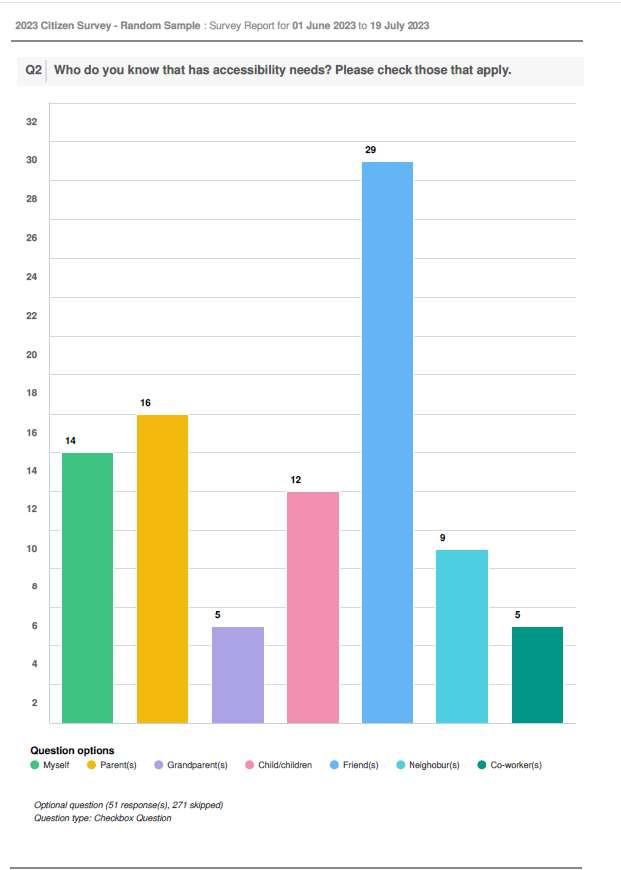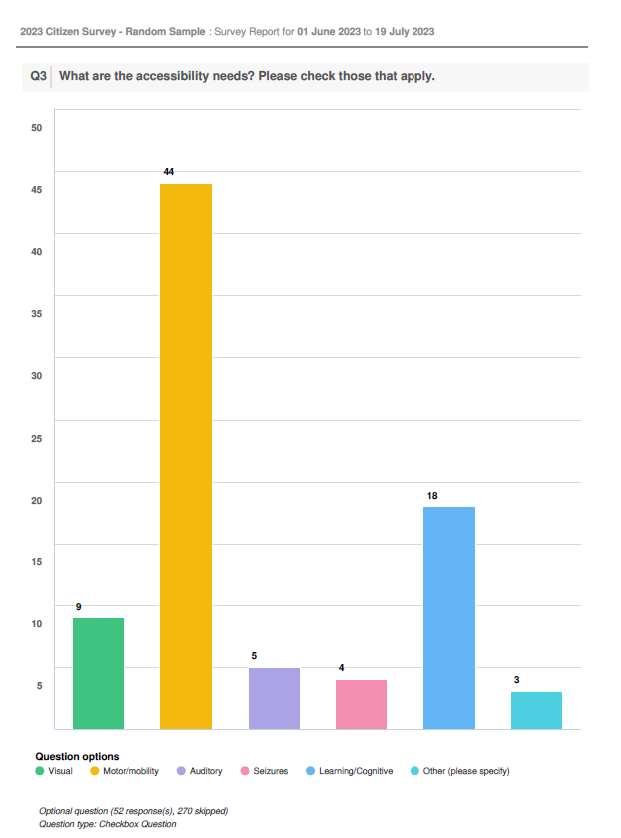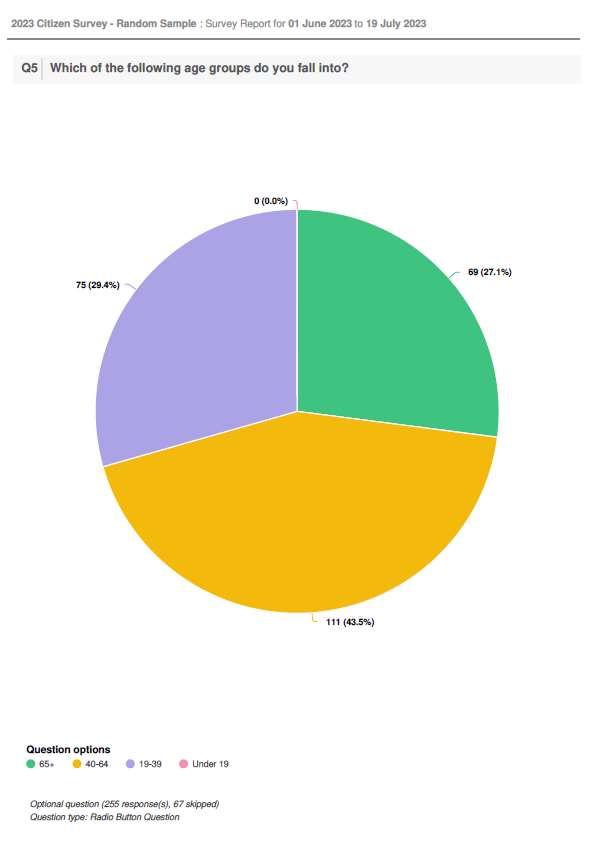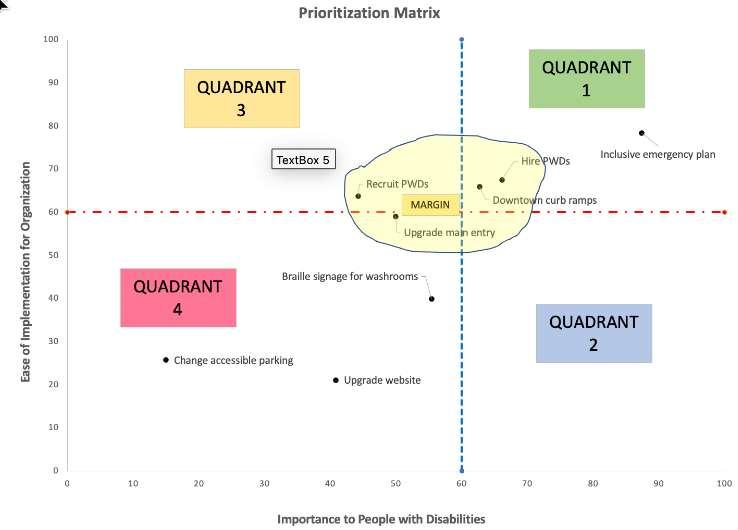City of Penticton Accessibility Plan 2023-2026
Prepared By: Social Development DepartmentDate: August 2023

1. Introduction
1.1 Land Acknowledgement
We acknowledge that our community is located on the traditional and unceded territory of the Syilx Okanagan People. We are thankful for the opportunity to live, work and play in this beautiful environment.
1.2 Acknowledgments
The Accessibility Task Force would like to thank and recognize all the Accessibility Task Force members, the community organizations and the residents who actively participated and thoughtfully contributed to the Accessibility planning and engagement process. In particular the Accessibility Task Force would like to thank Mike Prescott from Disability Alliance BC and Vittoria Spindor from CNIB for their contributions in the development of the City of Penticton 2023 2026 Accessibility Plan.
Accessibility Task Force members include:
Trisha Kaplan (Chair)
Kona Sankey (Vice Chair)
Kristi Bauman
Randy Boras
Victoria Jaenig
1.3 Executive Summary
James Ludvigson
Heather Miller
Grant Pattingale
Leanne Williams
In September 2022, the Province of British Columbia introduced new provincial legislation mandating municipalities to create a plan that provides clarity about accessibility requirements and outlines how to achieve barrier-free public access to all municipal services and facilities.
The Accessible British Columbia Act requires municipalities and other prescribed organizations to establish an accessibility committee, to create an accessibility plan that identifies barriers and proposes actions to remove and prevent barriers to municipal services and facilities. The Actalso requires that the accessibility committee implement and maintain a public feedback mechanism to ensure the public has an opportunity to provide ongoing 1, 2023. The Actstipulates that the plan must be updated a minimum of every three (3) years thereafter.
On May 3, 2023 the City of Penticton convened the Accessibility Task Force to carry out the required actions. This Task Force, chaired by Trisha Kaplan, included nine (9) members of the public, and was supported by City staff and Councillor Ryan Graham as the Council Liaison.
Through the planning process, the Task Force successfully identified over thirty (30) barriers and over forty (40) potential actions to remove and prevent these barriers. Specific priority accessibility areas include: employment and staff, delivery of services, the built environment, and information and communication.
1.4 About the Organization
As a city of 37,000 residents, Penticton has grown into a tourist town and bustling city while offering residents tremendous assets including the South Okanagan Events Centre, the Community Centre, Cleland Community Theatre, the Trade and Convention Centre and a variety of parks and sports fields. Residents also enjoy state-of-the-art infrastructure, ensuring the quality of water is among the best anywhere, and benefit from being one of five municipalities in the province that operate its own electric utility.
our lakes and beaches, wine and orchards, or the wide range of outdoor recreational activities that abound. Hop on your bike to discover awardwinning wineries and trails with stellar views. Shop at the bustling outdoor market, peruse art galleries, enjoy festivals, or go skating at the outdoor rink. Ski champagne powder slopes or take in a hockey game or concert at the South Okanagan Events Centre.
Council has laid out four strategic priorities to provide a foundation as we continue to grow and develop: Safe and Resilient, Livable and Accessible, Vibrant and Connected, and Organizational Excellence. The pages that follow infuse action into those priorities as we build a stronger and more inclusive Penticton.
1.5 Our Accessibility Story
The Task Force entered this process wanting to lay down a foundation Members have drawn on their own lived experiences to detail how much work remains to be done to improve accessibility. There are many ways to improve accessibility, and it was important that the guiding principles, vision and actions in this Plan be informed by the unique needs of Penticton.
Though this may be just an initial step towards preventing and removing accessibility barriers, we hope that our meaningful process to create this Plan provides a roadmap for other communities and organizations. Those who have served on the Task Force felt it was an opportunity to turn good intentions into meaningful changes that will impact everyday lives.
1.6 Message from Mayor Julius Bloomfield

When City Council was deciding on the four priorities that would guide Penticton for the next four years, it was important that the goals we set worked together to ensure our community was an inclusive one where every person felt like they could participate and take part in the life of the city.

A key aspect was ensuring Penticton was a livable and accessible community, one where obstacles are removed and replaced by equal access to services and amenities. The Accessibility Task Force was created to identify accessibility barriers that exist when community members are interacting with the City, and to make recommendations to remove those barriers when community members are interacting with the City.
The task was intentionally broad and was designed to allow the nine Task Force members to highlight areas where we can improve on work already being done and also inform on areas where we need to increase our response.
What follows on the pages of this report is a blueprint on how to turn our priority alivableand accessiblecity into concrete action. It provides us with information from those who are facing the challenges, who want to be part of the community and have now told us how we can make that happen.
I want to thank the Task Force members for all the work they have put into getting us to this point. The committee membership was comprised of those who have lived experience and those who have a passion for creating an accessible Penticton. That knowledge and passion is reflected in this living document, and will ensure all our residents have fair and full access to City Services, programs and spaces.
1.7 Message from Accessibility Task Force Chair

On behalf of Penticton's Accessibility Task Force, I am pleased to share the new Accessibility Plan with you.
When BC created the Accessible BC Act in 2021, it required each municipality to create an accessibility committee, develop an accessibility plan and establish a framework for public feedback. This presented the City of Penticton with the opportunity to reflect on the work they had already undertaken to improve accessibility, identify barriers that still exist, and define a strategy for their removal.
The Accessibility Task Force was made up of citizens who have lived experience across a variety of disabilities, as well as others with a deep passion for creating a more inclusive community. Currently, one in five (1 in 5) Canadians lives with a disability, and this is growing as our population ages. With new feedback options in place, I encourage you to share your experiences and suggestions on areas for improvement.
Penticton is a vibrant community to live in, a top tourist destination and a popular retirement community, and everyone interacts with municipal services, programs and spaces. It is so important that everyone be able to fully participate in all that Penticton offers, and we hope that this Accessibility Plan will lead the work to achieve a fully accessible community!
Trisha Kaplan AccessibilityTaskForceChair
1.8 Definitions
In this document:
refers to the plan created by the Accessibility Task Force and ultimately adopted by Penticton City Council.
Accessibility Task Force refers to the council committee made up of 9 members of the public who participated in the development of the Accessibility Plan.
refers to the Accessible British Columbia Act.
refer to areas in which barriers to accessibility can exist, such as employment and staffing, delivery of services, the built environment, information and communications, transportation, health, education and procurement
refers to anything that hinders full and equal participation in society. Barriers can be caused by architectural and structural builds, attitudes, beliefs and social biases, information and communication, the physical environment, technology and policies and practices.
refers to the Corporation of the City of Penticton
refers to an inability to participate fully and equally in society as a result of the interaction of disability and a barrier
ity Plan 2023-2026.
refers to the Accessibility Task Force.
2. About the Task Force
The Actmandates all municipalities and prescribed organizations to have an accessibility committee endorsed the Terms of Reference of the Accessibility Task Force, which was intended as a time-limited group with the purpose of developing the Accessibility Plan.
2.1 Task Force Members and Background
The Actrequires that at least half of the Committee members are persons with disabilities or individuals who support them, or are from organizations that support, persons with disabilities. It also requires that at least one member of the committee is an Indigenous person and that the committee reflects the diversity of persons in British Columbia. Council appointed nine committee members to an Accessibility Task Force
Members of the Task Force shared a commitment to serve their community and an appreciation for the challenges many individuals experience while accessing community services and facilities. The City of
City of Penticton Accessibility Plan 2023-2026
(non-voting) and one (1) staff liaison (non-voting).
2.2 Focus of the Accessibility Task Force
The purpose of the Accessibility Task Force was to assist the City of Penticton in identifying barriers for Penticton on how to remove and prevent barriers for those individuals. They identified barriers within specific categories such as, architectural and structural builds, attitudes, beliefs and social biases, information and communication, the physical environment, technology and policies and practices. From there, they identified tangible actions that the City of Penticton could take to improve accessibility across City services.
2.3 Vision Statement
Additionally, the Accessibility Task Force endorsed a strategic vision statement to best describe the outcome that the City of Penticton envisions achieving with the Accessibility Plan. It is as follows:
TheCityofPentictoniscommittedtoensuringthatresidentsofallabilitieshaveequal and independent access to municipal services and aims to remove barriers to continuallyimprovetheaccessibilityofourcommunity,ensuringthatallresidentsand visitorsexperiencethesamequalityoflifethroughoutallseasons.
A strategic vision statement ensures that the goals for accessibility are future-driven and continuously embraced by the City, regardless of external factors, circumstances or current trends. It is a commitment to a purpose and establishes how an organization, such as the City of Penticton, will focus on its mission.
3. Guiding Principles
3.1 Accessible BC Act Guiding Principles
Guiding principles are values that set a standard for how the Accessibility Task Force and the City will identify, remove and prevent barriers to accessibility. They are important as they set a tone for the approach of an organization towards its goals, and they assist in decision-making. Guiding principles shape the culture and behaviour of the organization and the work being done.
The Government of British Columbia adopted a set of guiding principles to steer the Provincial Accessibility Committee as they developed accessibility standards. The principles are: inclusion, adaptability,diversity,collaboration,self-determination and universaldesign The Actrequiresthat these principles be considered by municipalities in the development of their accessibility plans.
3.2 Accessibility Task Force Guiding Principles
In addition to the guiding principles set by the Government of British Columbia, the Accessibility Task Force devised their own set of principles in order to reflect the unique needs and conditions of the City
of Penticton. These guiding principles were identified as: all-seasonaccessibility,independenceand dignity,safetyandsecurity,livedexperience,user-centeredapproachand meaningfulengagement.
The intent of these principles was to guide the work of both the Accessibility Task Force as it identifies and prioritizes actions for the Plan, as well as for the City as it carries out the necessary work to create a fully inclusive and accessible community.
4. Consultations and Engagement
The Accessibility Task Force used the following approaches to engage the community and create Although the short one (1) year timeframe set by the Province to form a committee and develop a plan did not allow for broad community involvement, the engagement completed did demonstrate a high degree of support for the work. The intent is for continued public feedback on both the Plan itself and the larger topic of inclusion and accessibility.
The Accessibility Task Force has acknowledged the importance of engaging the community and has recommended several opportunities for future engagement. A number of individuals, local improve barrier-free access and their involvement will be critical as the Plan is implemented (see Appendix A).
4.1 Accessibility Task Force
Nine community members were appointed by Council to develop the Accessibility Plan. A task force is an effective and collaborative engagement technique when gathering and reflecting diverse perspectives. Although this approach cannot replace the broader public involvement, it does help to build a sense of partnership within the community and promotes meaningful input, based on community perspectives and personal experiences.
According to the International Association of Public Participation (IAP2) and its Spectrum of Public Participation, this level of engagement is identified as a collaborative approach. The City supports the International Association of Public Participation (IAP2) and its Spectrum of Participation. The IAP2 philosophy and practices and is committed to involving the community in decisions that matter to them, whenever possible.
PromisetothePublic(Collaborate):Wewilllooktoyouforadviceandinnovationinformulating solutionsandincorporateyouradviceandrecommendationsintothedecisionstothemaximumextent possible.(Source: IAP2)
Two engagement exercises were held with the Accessibility Task Force to best understand barriers and actions for the Accessibility Plan.
The first was a Visioning Exercise. The Task Force was asked hatdoesanaccessiblePentictonlooklike Accessibility Task Force members held a discussion around this topic and identified both barriers and solutions. Detailed notes were taken from the discussion and a content analysis was
subsequently performed on the comments to best understand, separate and categorize barriers and actions to remediate these barriers
The second engagement exercise was the Prioritization Exercise. This comprised of rating both the importance of each item to people with disabilities as rated by the members of the Accessibility Task Force, and the feasibility, or ease of implementation, based on the knowledge of City of Penticton staff.
4.2 Citizen Survey
A Citizen Survey was made available to Penticton residents to gain public feedback on municipal matters that impact daily life. Four questions related to accessibility were asked in an effort to better collected, which has helped to inform the work and recommendations of the Task Force. A key finding was that there is very low public awareness about the need for barrier-free access in the community and the access challenges that some residents face (see Appendix B).
4.3 City of Penticton Website Feedback Page
The Actrequires a mechanism for feedback on the Plan and on barriers in the community. As part of this initiative, a new page on the City of Penticton Plan and provide a feedback mechanism for the public to report barriers and suggestions. To assist the public in finding the feedback webpage, the page is linked in several areas of
4.4 Community Awareness
To promote community awareness about the Plan, and the role of the Accessibility Task Force, several communication methods were employed. Key aspects are outlined including communication objectives, key audiences, and delivery timelines. Strategies to support communication efforts included:
a. Accessible City Webpage: Content was updated, highlighting how the City is working toward greater accessibility for residents who interact with City services and facilities. The Accessibility Task Force is introduced in addition to the mandate to develop a draft Accessibility Plan by September 2023, as required by Provincial legislation. Details on how to provide public feedback is also outlined.
b. Feedback Form: An online feedback form was created and posted to the Accessible City Webpage inviting feedback based on personal experiences regarding the accessibility of City services and facilities. Questions and information gathered will focus on the identification of barriers and potential solutions to help remove and prevent further access challenges for users
From the period of July 14, 2023 August 8, 2023, over 20 responses were collected
c. Media Release: The was highlighted in a media release The media release introduced the Accessibility Task Force and its mandate to complete the Accessibility Plan It also defined accessibility and outlined the scope of the Accessibility initiative, project timelines and how to get involved. The Accessible City webpage was promoted as an information source to learn more about barriers in our community
City of Penticton Accessibility Plan 2023-2026
d. Promote Task Force Members via Profiles: Voluntary profiles were created to showcase the Task Force members and to learn who they are, their background and interest in accessibility. Profiles are featured on the Accessible City webpage.
5. Accessibility Barriers
5.1 Identifying Accessibility Barriers
Barriers can be anything that hinders full and equal participation in society They can be anything that prevents people with disabilities from being included. Barriers can be caused by architectural and structural builds, attitudes, beliefs and social biases, information and communication, the physical environment, technology and policies and practices.
The following are accessibility barriers that were identified through the Accessibility Task F Visioning Exercise, the Citizen Survey and some preliminary barriers identified through the Accessibility Feedback Form. A robust process involving City staff and the Accessibility Task Force was used to prioritize actions based on importance and feasibility. The results are shown in Appendix C
5.2 Accessibility Priorities
The following summarizes the outcomes of the Prioritization Exercise, conducted by the Accessibility Task Force, to determine the level of importance of each barrier and the ease of implementing a and improvement or removal of the barrier, as assessed by City staff.
Essential Priority HighImportanceandHighFeasibility
1. Require accessibility training for staff
2. Create an accessibility policy to protect and assist staff
3. Examine the City of Penticton website for accessibility and summarize findings
4. Offer live closed captioning during City Council meetings
5. Create an accessibility advisory list to consult on City projects for accessibility
6. Ensure accessibility features are piloted with people with disabilities
7. Examine bus stops for accessibility and summarize findings
8. Examine progress reporting mechanisms both internally and externally
Significant Priority HighImportanceandMediumFeasibility
9. Create an accessible notification system for emergencies
10. Create accessibility policies for City projects
11. Advocate to BC Transit for accessible buses
12. Geo-map accessibility barriers in Penticton
13. Undertake a public education campaign about accessibility and disabilities
14. Examine City services for accessible alternatives and summarize findings
15. Examine the City o
16. Hire people with disabilities
1.1
Moderate Priority MediumImportanceandMediumFeasibility
17. Install wayfinding in City buildings
18. Examine bike lanes for accessibility and summarize findings
19. Meaningfully engage with residents with disabilities on a continuous basis
20. Create an Accessible Independent Resident Policy
6. City of Penticton Action Plan 2023-2026
An accessibility plan provides a framework and actions to identify, remove and prevent barriers for all community members and visitors. The City of Penticton created its Accessibility Plan in consultation with the Accessibility Task Force. A high-level overview of the Plan are outlined below in Table 1. Details on how these actions were determined can be found in Appendix D.
Table 1: Employment and Staff
Action Details
Offer accessibility training for staff Education about disabilities, accessibility and adaptation, and barriers to accessibility.
1.2
Create an accessibility policy to protect and assist staff. Include ensuring that current policies are not causing harm and creating biases in staff against staff with disabilities.
Essential Policy and Practice
1.3
Hire people with disabilities. Include ensuring that hiring policies are effective for people with disabilities.
Table 2: Delivery of Services
2.2
2.3
Significant Policy and Practice / Attitudinal and Social
Action Details Priority Level Identified Barriers
Examine the City of Penticton Website for accessibility and summarize findings.
Complete an accessibility audit. Essential Information and Communication / Technology
Advocate to BC Transit for accessible buses. Communicate the findings of accessibility engagements to BC Transit.
Significant Physical / Architectural and Structural
City of Penticton Accessibility Plan 2023-2026
2.4
Examine City services for accessibility alternatives and summarize findings.
Create accessibility policies for City projects.
2.5
Create an Accessible Independent Resident Policy.
2.6
3.1
3.2
3.3
3.4
3.5
Complete an accessibility audit. Significant Policy and Practice
The intent is a policy that requires accessibility to be integrated into City projects early and throughout the process.
The intent is to ensure that community members are able to use all City services independently and with dignity.
Table 3: Built Environment
Action Details
Examine bus stops for accessibility and summarize findings.
Ensure accessibility features are piloted with people with disabilities.
Examine City spaces for accessibility and summarize findings.
Install accessible wayfinding in City buildings.
Examine bike lane for accessibility and summarize findings.
4.1
Significant Policy and Practice / Attitudinal and Social
Moderate Policy and Practice / Physical
Priority Level Identified Barriers
Complete an accessibility audit. Essential Architectural and Structural / Physical
This is to ensure that accessibility features in the community are truly effective and serve their purpose.
Accessibility audit. This may include buildings, parks, beaches, roads, sidewalks, dog parks, etc.
This is the use of signage, colour and design elements to help occupants navigate a space.
Essential Policy and Practice
Significant Architectural and Structural / Physical
Moderate Architectural and Structural
Complete an accessibility audit. Moderate Architectural and Structural / Physical
Table 4: Information and Communication
Action Details Priority Level Identified Barriers
Examine progress reporting mechanisms both internally and externally.
This is to ensure that both community members and internal staff are kept up to date on the items of the Accessibility Plan.
City of Penticton Accessibility Plan 2023-2026
Essential Information and Communication
4.2
Offer live closed captioning during City meetings.
Both online, on Zoom, and on the TVs in the Council Chambers.
Essential Information and Communication / Technology
4.3
Create an advisory list to consult for City projects for accessibility review.
Geo-map accessibility barriers in Penticton.
This list will consist of local individuals who have lived experience with disability and who will be available to internal staff to provide feedback on City projects.
Essential Information and Communication
4.4
4.5
Create an accessible notification system for emergencies
This would be similar to the CommuniTREE Plan Map, where residents can pinpoint places in Penticton that are accessible and not-accessible.
Looking at where we can bolster our notification systems for people with different kinds of disabilities.
Significant Information and Communication / Technology
4.6
Undertake a public education campaign about accessibility and disabilities.
Meaningfully engage with residents with disabilities on a continuous basis.
Meant to remove biases and attitudinal barriers within the community.
Significant Information and Communication / Technology
Significant Information and Communication / Attitudinal and Social
4.7
The feedback mechanism required in the Act will play a role in this, but may include other strategies for an open line of communication between the City and Penticton residents with accessibility needs.

